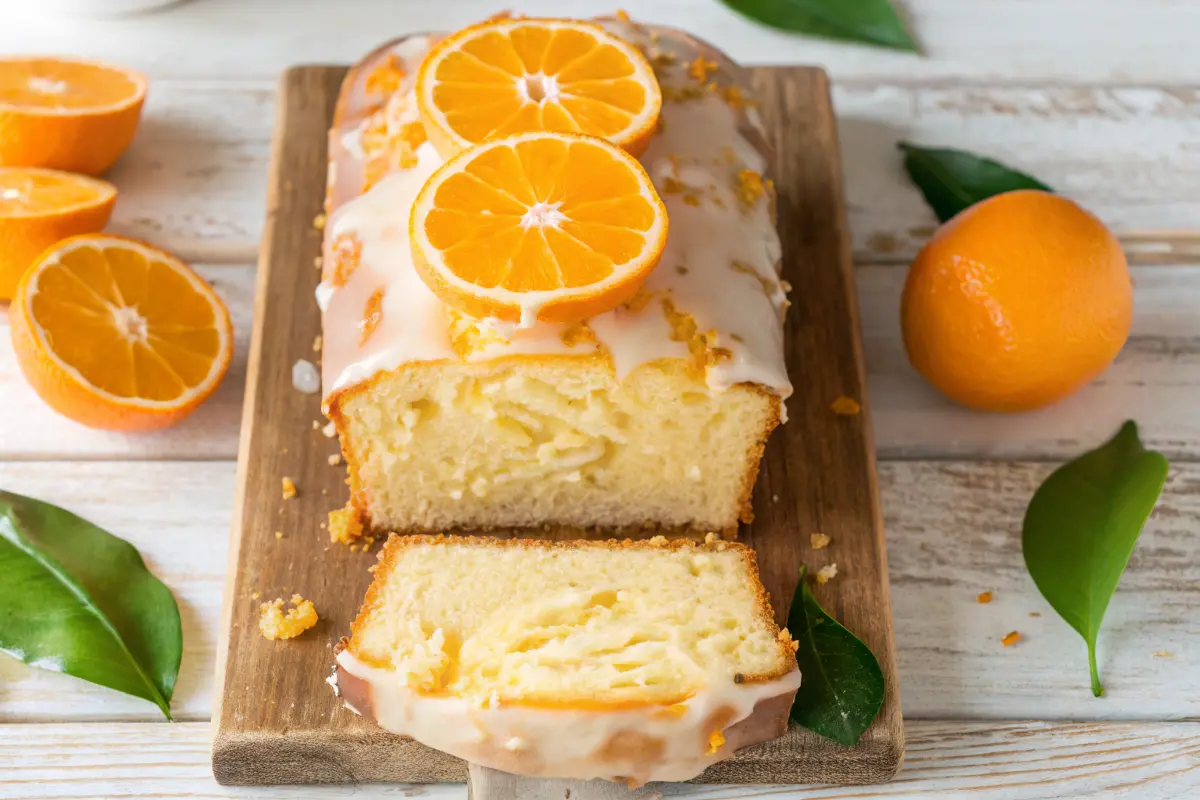Few desserts feel as timeless or as giftable as a beautifully domed Orange Glazed Pound Cake. The crumb is close and tender, the zest perfumes the whole kitchen, and the glossy orange glaze catches the light like stained glass. This guide walks you through everything for a bakery-level result at home: the classic creaming method, a triple-orange flavor strategy (zest, syrup, and glaze), airtight troubleshooting, and smart storage so each slice stays moist and aromatic for days. What is a Pound Cake?
What Is Orange Glazed Pound Cake?
At its heart, a pound cake is a butter-forward loaf historically based on equal “pounds” of butter, sugar, eggs, and flour. Modern bakers refine that formula for better lift, tenderness, and orange intensity. For citrus, we build flavor from oils in the zest and fresh juice; some bakers also brush on a light syrup before glazing for an extra burst. The result is a cake with classic structure and a gleaming finish—simple, striking, and impossible to resist.
Ingredients for Orange Glazed Pound Cake
For the cake
- Unsalted butter, room temperature — Soft butter aerates with sugar during creaming, laying the foundation for lift and fine crumb.
- Granulated sugar — Dissolves into butter, creating micro-air pockets; it also drives browning and the classic crust.
- Large eggs, room temperature — Provide structure and richness; add one at a time for a satiny batter.
- All-purpose flour — The backbone of the loaf. Measure accurately (ideally by weight) or spoon-and-level to avoid excess density.
- Fine salt — Balances sweetness, intensifies citrus.
- Leavener (optional, small amount) — A modest touch of baking powder softens the crumb without losing “pound cake” character.
- Fresh orange zest — The single most potent orange flavor source. Zest directly over the bowl to capture oils.
- Fresh orange juice — Adds real citrus lift; use just enough for flavor without thinning the batter too much.
- Vanilla or orange extract (optional) — A subtle back-note that rounds the citrus.
For the optional syrup
- Fresh orange juice + sugar, lightly simmered. Brushed onto the warm loaf, it boosts orange notes and keeps slices luscious.
For the glaze
- Confectioners’ sugar + orange juice + a little zest. Optionally whisk in a teaspoon of melted butter or milk/cream for sheen and a softer bite.
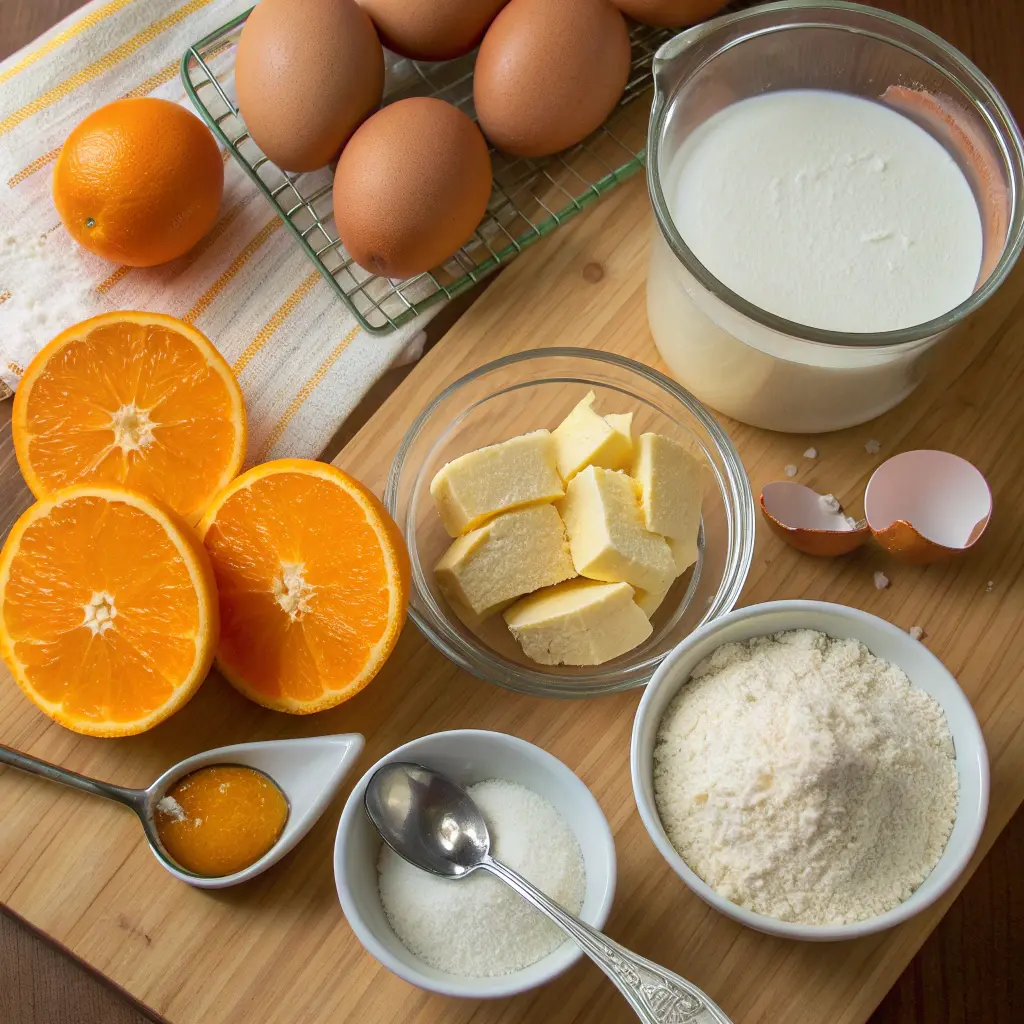
Tools & Pan Choices
- Loaf pan: 8.5×4.5″ gives height and a dramatic crack; 9×5″ yields a slightly flatter top and may finish a bit sooner.
- Microplane: for ultra-fine zest that melts into the batter and glaze.
- Stand mixer or hand mixer: consistent creaming equals consistent crumb.
- Oven thermometer: confirms that 325–350°F is really what your oven delivers.
- Cooling rack & pastry brush: essential for even syrup brushing and drip-line control.
Step-by-Step: Batter to Bake
- Prep
- Bring butter and eggs to room temperature. Grease and line your pan with a parchment sling. Preheat oven to 325–350°F (163–177°C), middle rack.
- Cream butter & sugar
- Beat butter until smooth and slightly lightened, then add sugar and cream 3–5 minutes until pale and fluffy. This step builds the cake’s internal scaffolding.
- Add eggs, one by one
- Mix on medium-low, scraping the bowl between additions to keep the emulsion silky and stable.
- Dry & wet components
- Whisk flour, leavener, and salt in a separate bowl. In a cup, combine orange juice with any dairy (if using) and vanilla.
- Combine
- Add dry ingredients in thirds, alternating with the wet mix in halves—beginning and ending with dry. Mix on low just to incorporate.
- Zest last
- Fold zest gently for maximum aroma.
- Pan & bake
- Smooth the top; tap the pan once to settle. Bake 55–75 minutes, depending on pan and oven. If browning too fast, tent lightly with foil.
- Doneness
- A skewer should come out with a few moist crumbs (not wet batter), and the center should reach roughly 200–205°F. Edges pull slightly from the pan.
- Cool 10–15 minutes in pan
- Loosen edges, then lift out to a rack to finish cooling—or to brush syrup while still warm.
Make the Perfect Orange Glaze
Base ratio: 1 cup confectioners’ sugar + 1–2 tablespoons fresh orange juice + ½–1 teaspoon finely grated zest.
- For a ribboning glaze that clings and sets opaque, aim for a slow, thick pour that holds stripes for 3–4 seconds before smoothing.
- Too thin? Add sugar by the tablespoon. Too thick? Add juice by the teaspoon.
- Whisk until completely smooth to avoid graininess; sifting the sugar first helps enormously.
- For extra sheen and a softer bite, whisk in 1 teaspoon melted butter or 1–2 teaspoons milk/cream.
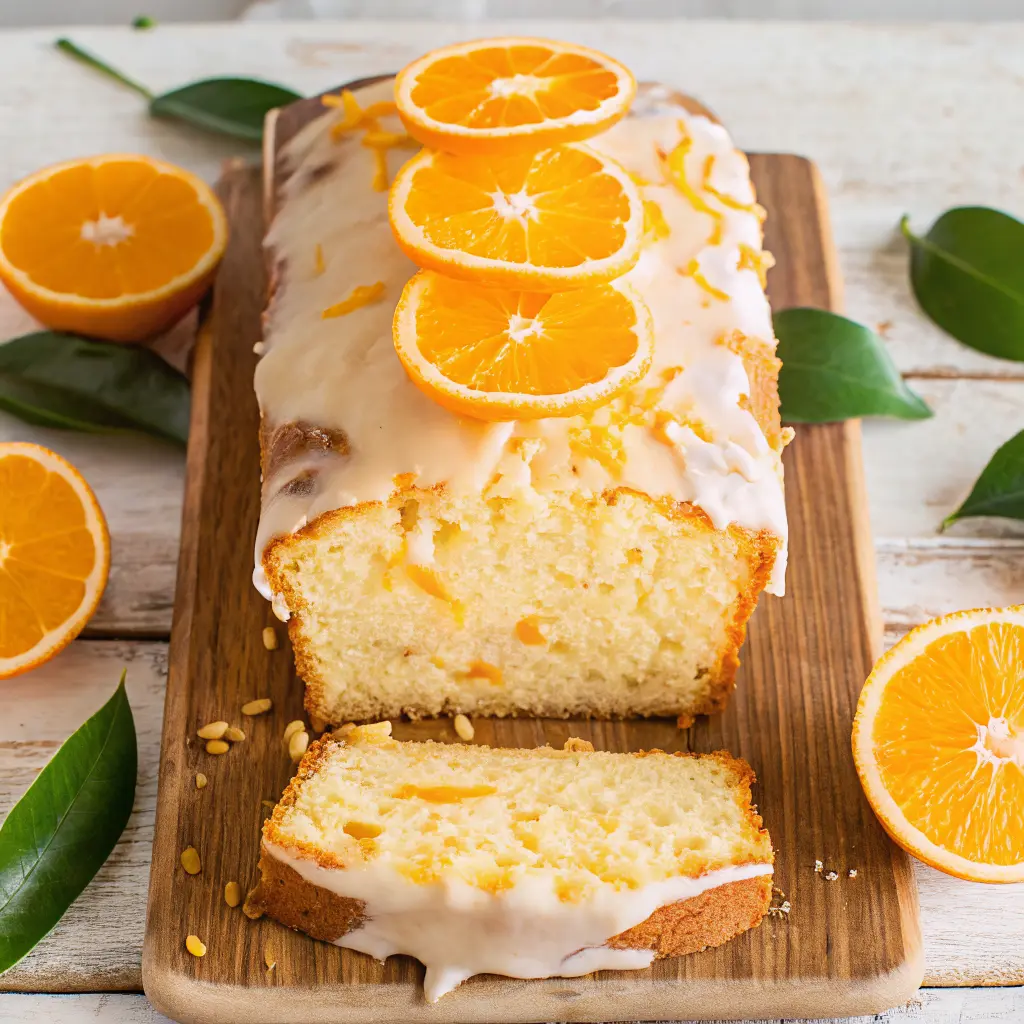
Common Mistakes & How to Fix Them
- Gummy/streaky texture
- Cause: underbaked center or overmixing after flour.
- Fix: bake until the middle passes the skewer test; fold gently once flour goes in.
- Sunken center
- Cause: too much leavener, batter over-aerated, or oven door opened early.
- Fix: measure leavener precisely; keep creaming within the 3–5 minute window; avoid unnecessary door openings.
- Dry edges
- Cause: overbake or hot spots.
- Fix: verify oven temp with a thermometer; tent with foil in the last 15 minutes; consider the syrup soak.
- Flat orange flavor
- Cause: relying on juice without zest, or old citrus.
- Fix: Use freshly zested oranges and add zest to glaze as well as batter.
Variations & Add-Ins
- Blood Orange Pound Cake — deeper color, raspberry-like undertone.
- Cara Cara or Clementine — softer acidity, very aromatic zest.
- Vanilla-Bean Glaze — whisk in seeds or paste for freckled elegance.
- Cream-Cheese Drizzle — richer finish; pipe in zigzags over a thin orange glaze.
- Liqueur Lift — 1–2 teaspoons Grand Marnier/Cointreau in glaze or syrup for a subtle, grown-up note.
- Poppy Seed — 1–2 tablespoons folded into batter for a delicate crunch.
Make-Ahead, Storage & Freezing
- Make-ahead: the citrus develops nicely by day two; glaze on bake day or the next morning.
- Room-temp storage: keep glazed loaf airtight for 3–4 days.
- Freezing: freeze unglazed halves or slices in double-wrapped layers for up to 2–3 months. Thaw, then glaze for the freshest look.
- Travel & gifting: glaze fully set before wrapping; parchment + a snug bakery box keeps the finish pristine.
Serving Ideas & Pairings
- Dust slices with a whisper of zest for sparkle.
- Serve with lightly sweetened whipped cream and macerated berries.
- Pair with espresso, black tea, or an orange-peel–forward herbal blend.
- For brunch boards, cut into thin fingers and stack alongside berries and shortbread.
Troubleshooting the Glaze
- Too transparent — Add more confectioners’ sugar; let the first pass set, then glaze again.
- Too thick to pour — Thin with juice by the teaspoon, whisking smooth.
- Grainy — Sift sugar first and whisk completely; tiny lumps show on a glossy finish.
- Sliding off — Cake was warm or glaze was too thin; wait until fully cooled and thicken the glaze.
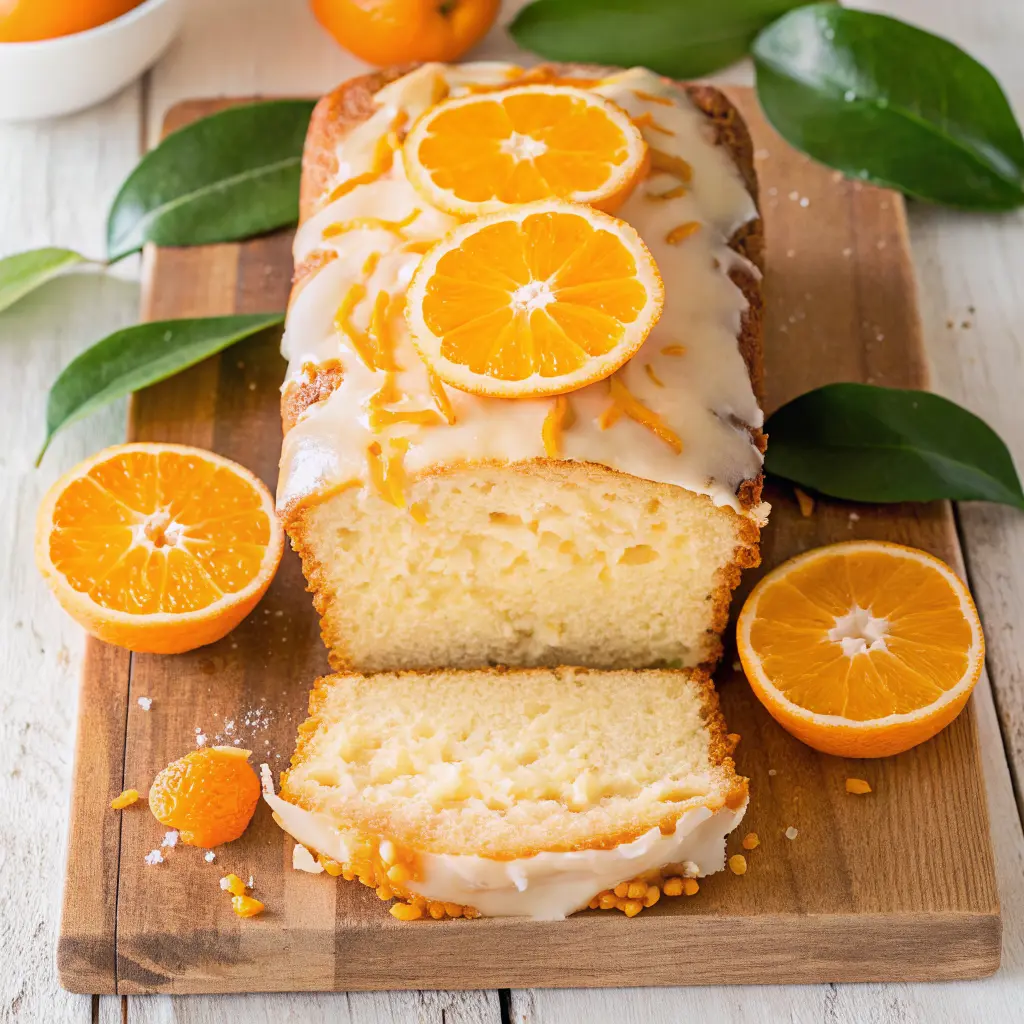
Frequently Asked Questions
How do I get bold orange flavor without bitterness?
Use plenty of fresh zest and avoid the white pith. Zest straight over the bowl to capture the oils. Pair that with just enough fresh juice in the batter and glaze. For an extra boost, use the optional syrup.
Can I substitute orange extract for zest?
Yes, but zest offers a fresher aroma with no “perfume” note. If using extract, start with ¼ teaspoon and adjust to taste; too much can overwhelm the batter.
Why did my cake sink or crack?
A shallow crack along the center is classic for loaves. True sinking often stems from too much leavening, underbaking, or opening the oven early. Measure carefully, bake until the center sets, and resist checking before the 45-minute mark.
How long should I cool before glazing?
Glaze only when the cake is fully cool to the touch. A warm loaf melts the glaze and sends it sliding off the sides.
Do I need baking powder in a pound cake?
Traditionalists skip it; modern bakers add a small amount for a slightly softer crumb and a gentler lift. Both approaches can be excellent—choose your texture.
Conclusion
A great Orange Glazed Pound Cake is all about balance—bright citrus aroma, a plush, fine crumb, and a glossy glaze that sets into picture-perfect drip lines. With the creaming method, fresh zest folded in at the end, and that optional syrup-soak for extra pop, you’ve got a loaf that slices cleanly, travels well, and tastes even better the next day.
Print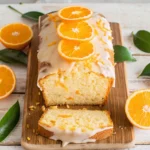
Bright Orange Glazed Pound Cake
- Total Time: PT1H20M
- Yield: 10 slices 1x
- Diet: Vegetarian
Description
This Orange Glazed Pound Cake is soft, buttery, and bursting with citrus flavor. Each bite combines the rich texture of classic pound cake with the fresh, tangy sweetness of a homemade orange glaze — perfect for brunches, tea parties, or a sunny afternoon treat.
Ingredients
Cake
- 1 cup (227 g) unsalted butter, room temperature
- 1 ¼ cups (250 g) granulated sugar
- 4 large eggs, room temperature
- 2 cups (240 g) all-purpose flour, spooned & leveled (or weighed)
- ½ tsp fine salt
- ½–1 tsp baking powder (optional, for slightly softer crumb)
- 2–3 Tbsp fresh orange zest (from 2–3 oranges)
- 3 Tbsp fresh orange juice
- 1 tsp vanilla extract (optional)
Optional Orange Syrup
- ¼ cup fresh orange juice
- ¼ cup granulated sugar
- 1 tsp finely grated zest (optional)
Orange Glaze
- 1½ to 2 cups confectioners’ sugar, sifted
- 2–3 Tbsp fresh orange juice (to consistency)
- ½–1 tsp finely grated zest
- 1 tsp melted butter or 1–2 tsp milk/cream (optional, for sheen)
Instructions
- Prep: Heat oven to 335–350°F. Grease your loaf pan and line it with a parchment sling.
- Cream: Beat butter until smooth; add sugar and cream for 3–5 minutes until pale and fluffy.
- Eggs: Add eggs one by one, mixing on medium-low and scraping down as needed.
- Dry mix: Whisk flour, salt, and baking powder (if using).
- Combine: On low speed, add dry mix in thirds, alternating with orange juice in two additions (plus vanilla). End with dry. Mix just until incorporated.
- Zest: Fold in zest gently.
- Bake: Spread batter in pan, smooth top, and bake 55–75 minutes (start checking at 55). Tent with foil if browning early.
- Cool & (optional) syrup: Cool 10–15 minutes, lift to rack, then brush all over with warm syrup if using. Cool completely.
- Glaze: Whisk glaze to a slow-ribbon consistency. Spoon or pour over the cooled loaf, nudging drip lines. Let it sit before slicing.
- Prep Time: PT20M
- Cook Time: PT1H00M
- Category: Desserts
- Method: Baked
- Cuisine: American
Nutrition
- Serving Size: 1 standard loaf
- Calories: 370kcal
- Sugar: 35g
- Sodium: 160mg
- Fat: 17g
- Saturated Fat: 10g
- Unsaturated Fat: 6g
- Trans Fat: 0g
- Carbohydrates: 50g
- Fiber: 1g
- Protein: 5g
- Cholesterol: 90mg

